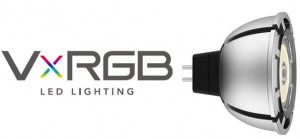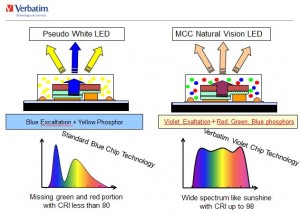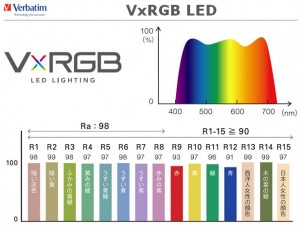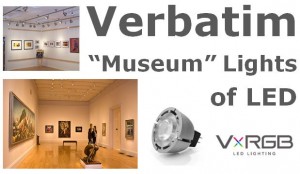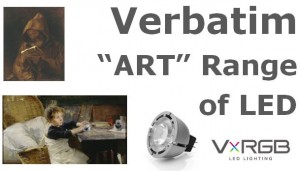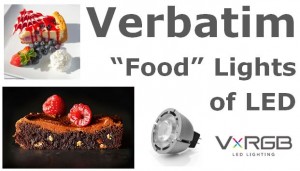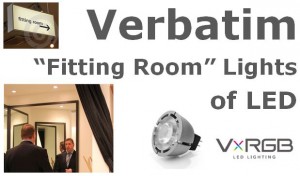Archive for July 2013
18
Verbatim’s new VxRGB LED lamp for True-Colour performance
Comments off · Posted by admin in LED, Uncategorized
An introduction to a very interesting new LED product that is specifically designed for high-end clients in jewelry stores, museums, high-end retail stores, hospitality etc.
We now sell the brand new Verbatim VxRGB True Colour LED lamp. The VxRGB is a special (only one in their range currently). It is designed as a ‘True Colour’ lamp, based on completely new technology that renders the entire colour spectrum (unlike old CRI/Ra standards which are skewed and incomplete esp. with LEDs). This lamp is manufactured using a violet chip (instead of blue), and uses a mix of red, green, and blue phosphors instead of just yellow phosphor. During a Verbatim demonstration we looked at a few sample items using standard halogen, standard LED, and the VxRGB, and sure enough the VxRGB made the colours really vital and clear (e.g. the guys navy blue sports jacket was really navy blue instead of black!). The VxRGB lamp works best by installing it alongside regular LED lamps, as the regular LED lamps provide the lumens output power, allowing the VxRGB to do the true colour lighting.
Clients are encouraged to offer the True Colour lamp supplemented with the regular LED lamps as a complete solution. This is very new to market, so allows for a differentiating sales pitch.
Please contact us for product presentation and technical information.
shuttla
LED · led art gallery · led fashion · led food · led hospitality · led lamp · led lighting · led museum · led retail · Novel Energy Lighting · verbatim · vxrgb
18
Reduce costs with LED – Kosnic and Professional Electrician June 2013
Comments off · Posted by admin in LED, Uncategorized
An interesting article by Kosnic:
LEDs were invented more than 50 years ago but they have taken decades to provide their worth in mainstream applications. Problems with colour rendition, lack of standardisation, and inability to dim have given LED lams a bad press and created confusion within the marketplace.
However, innovations in LED lighting technology and new product development are prompting an e-evaluation of whether now is the right moment to realise the carbon savings and energy efficiency of LEDs.
There are three main benefits of LEDs:
Robust
LEDs are solid state light sources and so are very robust. While an incandescent lamp will last for approximately 1,000 hours, an LED alternative will last for up to 40,000 hours. Many manufacturers will be happy to guarantee this period of operation, offering free replacements in the event of early failure.
Therefore, an LED lamp fitted in a reception area and used for seven hours every day of the week, will still be functioning after 10 years. This delivers both energy and maintenance savings. In a large office or hotel, it is common to find one person from the mainainance stream dedicated to changing light bulbs! Switching to LEDs allows mainainance staff to focus on other activities.
Energy savings
The real cost savings, however, are apparent when calculating energy savings. LEDs are highly efficient light sources that release only a tiny amount of heat and have low power consumption. There are millions of GU10 halogen lamps in use within canteens, reception areas, consulting rooms, etc. The LED direct replacement for this halogen lamp is 88% more efficient giving the following cost-benefit calculation:
The cost of the 50W GU10 is £1.00
The cost of a LED replacement is £9.00
If the lamp is lit for 12 hours per day, with an electricity cost £0.12 per KWH, the cost of operation for the conventional lamp will be £20.00 per year, whereas the LED is only £2.40. Even taking the initial purchase price in to consideration, the payback period will be seven months. Remember, these are the figures for only one lamp.
Versatile
Many LED lamps can be retrofitted in five minutes and, unlike old-style bulbs, they light instantly. Businesses should look for quick wins such as areas where lamps are lit for long periods and lights are kept on for more than 5 hours a day. Good examples include corridors, stairwells and landings, reception areas, offices and warehouses, and canteens and rest rooms. Used in these areas, LED lighting can also provide a better quality of light than traditional bulbs – eliminating flickering and associated ailments such as headaches and eye strain. LED lighting also gives off negligible heat and so is safer for environments where lamps are situation close to staff.
This safety, the need of the public sector to tackle carbon emissions and reduce costs, coupled with product innovation from LED manufacturers means that re-evaluating lighting strategies is now a potentially highly valuable exercise.
shuttla
energy saving · lamps · LED · LED lamps · lighting · payback
LED lighting saved £430 million worth of electricity in the US last year, according to a study by the US Department of Energy. Focusing on the most common lighting applications, the DoE estimated that 49 million LED lamps and luminaires were installed last year, saving about 71 trillion units.
©Lux Magazine, July-13
Shuttla
www.novelenergylighting.com
DOE · electricity savings · LED · led bulbs · LED lamps · lux magazine · Novel Energy Lighting

